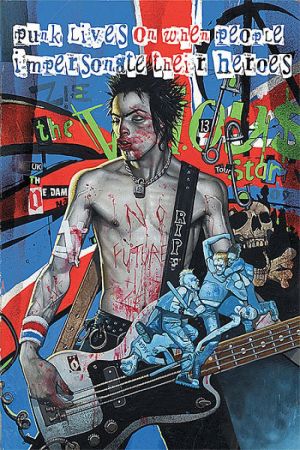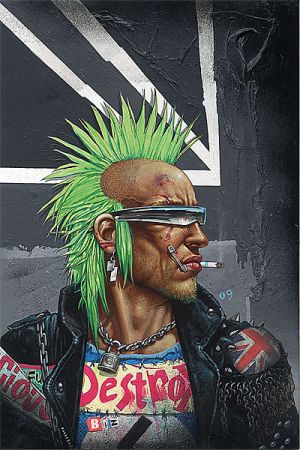Hellblazer: No Future
By Andy Frisk
July 27, 2010 - 22:20
DC Comics
Writer(s): Peter Milligan
Penciller(s): Simon Bisley
Colourist(s): Trish Mulvihill
Letterer(s): Sal Cipriano
Cover Artist(s): Simon Bisley
Writer Peter Milligan’s run on Hellblazer has been a great one. Milligan has brought back a little of the punk spirit that was once part of the classic Constantine sneer and story. Sly political commentary on post-colonialism as seen in the recent Hellblazer: India story arc and left and right wing politics as seen in “No Future” each represent Milligan’s concerns with the state of state affairs, so to speak. These themes, mixed with Constantine’s charm and tricks, make for a grand series of intelligently crafted picaresque stories that not so subtly make some interesting statements. In “No Future”, Milligan takes Constantine full circle from young punk to old punk, and like he has with Hellblazer the series, Milligan revitalizes a bit of the punk spirit in old man Constantine himself.
 |
“No Future” opens with Constantine and his tag along wannabe lover named Epiphany, who’s an alchemist and the daughter of a major crime boss, back in Brixton after their recent adventures in India. Constantine is wrung up by an old friend of his from his days as a punk rocker who goes by the name Faeces McCartney. It seems Faeces is still fighting the good fight and preaching anarchy in the UK while leading a group of kids he’s nicknamed The Vicious, which Faeces describes as “our punk-anarcho collective.” Faeces has a problem though. He’s collected, over the years, a number of relics associated with the long deceased Sex Pistol’s bassist Sid Vicious (a “no talent prick” as Constantine rightly observes) which include “his old biker boots…the syringe he killed himself with, (and) the knife said to have been used on Nancy Spungeon” (Sid’s girlfriend who he is believed to have murdered during a heroin binge) which “called to Sid’s restless wandering punk spirit.” Yes, it appears that Faeces has managed to call forth and give a home to the ghost of Sid Vicious with his little shrine and effigy dedicated to him. This ghost has been rocking The Vicious and providing its members with the ultimate trip…a trip of a supernatural kind. He’s getting weak though, and the kids are wondering away. Enter Constantine…
When Constantine, with the aid of his reputed occult powers, determines that there is definitely something supernatural inhabiting Faeces’ shrine to Sid, he decides to investigate who is recruiting Faeces’ kids away from The Vicious, and for what purpose. Constantine, hilariously decked out as the punk he very much looked like when he was young, discovers that some very nasty pre-Christian deities are reanimating the corpses of the UK’s old conservative Tories, and they’re out to take back the country. The stage is set for a poltergeist punch out between the evil ghosts of the conservatives past and the “punk-anarcho collective” spirit of Sid Vicious…with Constantine and his complicated relationship with Epiphany (who’s half his age as an early 20 something) caught in the middle.
Constantine doesn’t jump at the chance to bail out Faeces and his little punk collective though. It’s when Epiphany takes an interest in one of the collective’s young punks that Constantine decides to get involved. Maybe he does so because he fears the wrath of Epiphany’s crime boss father if she gets hurt through association with him. Maybe he does so because he’s a bit jealous (that’s Epiphany’s take on the subject). Either way we’re never too sure, but with Constantine it’s hard to be sure of his motives at any time. There is a third possible motive though. It’s one that reveals the hidden depth of emotion and decency in Constantine’s character: he doesn’t want to see the evil rotters win.
Herein is where we get down to the fun, sarcasm, and obvious (if still relevant) political and social commentary on Milligan’s part. The old conservatives are possessed by evil spirits who are seeking violent change while longing for a fascist like state to become the standard in the UK. One could easily say that Milligan is simply being one dimensional and preachy: conservatism=evil and liberal=good, etc, etc. When it’s revealed though that the spirit inhabiting Faeces’ Sid Vicious effigy and shrine is one of the same old gods that’s reanimating the dead conservatives, things aren’t so tidy and transparent anymore. Yes, the ghost in the Sid Vicious effigy ends up consuming the ghosts of the conservatives, but without Faeces’ punk collective to power Sid’s animating ghost and the right wing defectors from Faeces’ collective to power the conservative ghosts, would there even be this battle going on? Even more profound, if the ghosts on both sides of the conservative/liberal debate are of the same origin and have the same general goal of anarchy in the UK…what does this allusion have to say about the whole choking and stinking mess that is the world of political discourse and divide? In “No Future” it appears that both sides are powered by their extremists (as are the ghosts). They both have the same goal, and it’s not a very worthy one. Both sides also have their own shock troops. One side just has cooler hair than the other…Finally, since the ghosts are of a pre-Christian nature, is Milligan suggesting that these types of extremist debates and political battles are now obsolete and should be treated as such in a Christian era? Also, how badly is humanity failing at the “love thy neighbor” rule since these ghosts are still active? There are plenty of ideas and themes to mull over in “No Future.” To me, that makes the story, if not truly literary, then at least truly interesting, engaging, and worthy of being read and discussed.
A story filled with such artful ideas deserves to be illustrated just as artfully. With Simon Bisley handling the artistic chores for “No Future,” we are assured of just that. Bisley brings to Milligan’s story his unique visual style which relies on a realistic representation of gritty detail encapsulated in a painted look. It’s a look that he made famous in the late 1980s and early 1990s on such titles as Judge Dredd and Lobo along with album cover art for the likes of Danzig. His powerful visual grasps on both the worlds of dark fantasy and gritty smash mouth punk grease and grime merge to perfectly suit Hellblazer in general and “No Future” in particular.
 |
Overall, for a tale involving the darkness, folly, and the debatable profundity of never growing up and never minding the bollocks, “No Future” is actually really funny. The images of a forty-something Constantine and his old friend from his punk days decked out in full on punk garb, complete with green mohawks, is much more amusing than striking in any sort of revolutionary way. No doubt Milligan and Bisley intend this to be the case. The story ends up falling on the left wing side of the debate suggesting an answer, but the story’s title “No Future” reveals its true meaning when we realize that the warring ghosts of the faux Sid Vicious and the Tories both have no future in a world where they end up cancelling each other out with their noise and violence, thusly failing to move the debate forward. It’s a lesson that we in the real world should take to heart.
Related Articles:
The Hellblazer #14
Hellblazer #15
Review: Hellblazer #13
Hellblazer #12
Review: Hellblazer #11
Review: The Hellblazer #10 (2016)
Review: The Hellblazer #9 (2016)
Review: Hellblazer #8 (2016)
Review: The Hellblazer #7 (2016)
The Hellblazer #6
